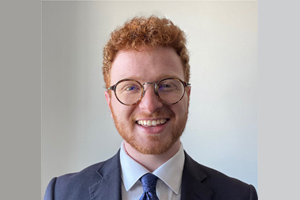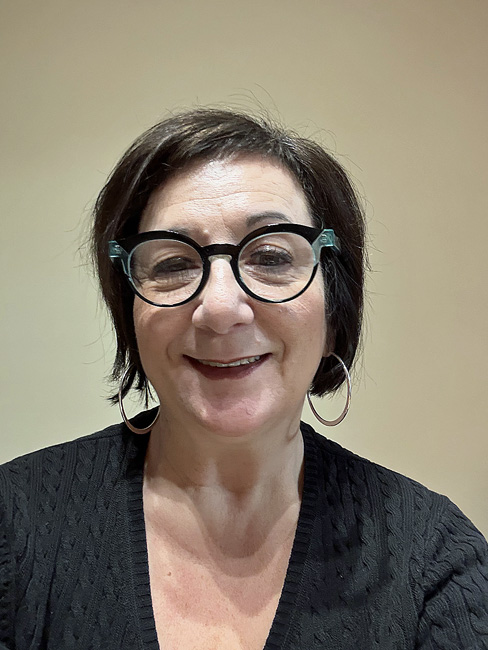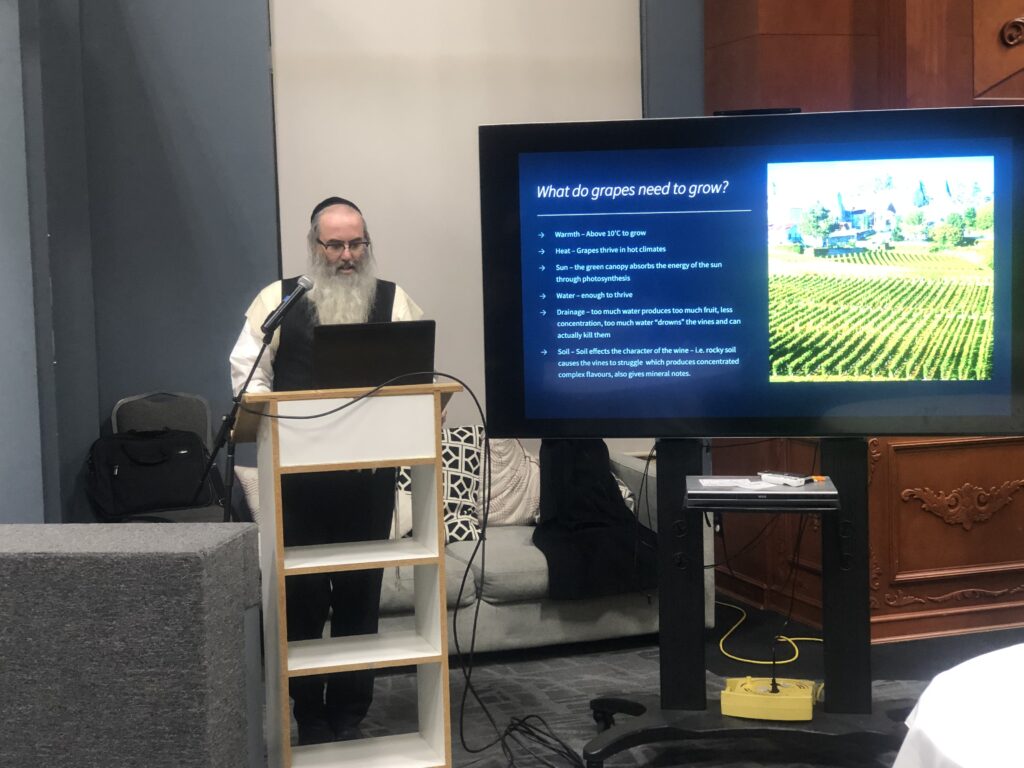Local News
Gray Academy graduate Jaron Rykiss is the new president of the University of Manitoba Students Union

By BERNIE BELLAN Twenty-year-old Jaron Rykiss is the newly elected president of the University of Manitoba Students Union. The results of the election, which was held online, were announced on April 1. (Voting began March 31 and was completed April 1.)
According to the university student newspaper, The Manitoban (which is now also entirely online), Jaron secured 63.6 percent of the votes cast. His only opponent, Savannah Szocs, received the other 34.6 percent.
The number of votes cast, not surprisingly, since very few students actually attend classes in person these days, was only 3, 453 out of 23,300 eligible voters.
Jaron Rykiss is the son of Lara London and Les Rykiss. He is also a graduate of Gray Academy (class of 2019).
In October 2020 I wrote a story about Jaron’s “gap” year in Jerusalem (http://jewishpostandnews.ca/8-features/598-jaron-rykiss-s-half-year-spent-on-exciting-kivunim-program-in-israel-cut-short-by-covid), which unfortunately was cut short by the advent of Covid late in 2019. The idea of spending a year in Israel was largely the result of a suggestion that former Gray Academy teacher Avi Posen had made to Jaron in his final year at the school, he told me in 2020.
Although Jaron was supposed to have spent eight and a half months in Israel in a program called “Kivunim”, he ended up returning to Winnipeg in March 2020 rather than completing the entire program, which would not have ended until May under normal circumstances.
Still, Jaron regarded his time spent in the program as extremely fulfilling. “We ended up going to Greece and Bulgaria for two weeks,” Jaron explained, after which the group returned to Israel for a month and a half, then India, but trips to Spain, Portugal, Italy, Germany, Hungary and Morocco were all canceled due to the outbreak of COVID.
“We were supposed to end up in Morocco and meet the king there,” Jaron noted. “It’s too bad that never happened.”
(Jaron added that they were also supposed to visit Turkey at the same time as they visited Greece and Bulgaria, but that didn’t happen either. As he explained, “there were a lot of political issues” – what with the heightened civil unrest in Turkey at that time.)
At the time I wrote that story I asked Jaron what his plans were now that he was back in Winnipeg. He said that he was enrolled at the University of Manitoba and was planning on majoring in Political Studies or Philosophy.
When I learned that Jaron had been elected UMSU president (as a result of an email I received from his grandfather, Jack London), I contacted Jaron to see whether he would be amenable to my interviewing him about what led him to want to attain that position.
Jaron explained during our phone conversation that it was during his first year in university (beginning that same fall when I initially spoke with him) that a friend of his in one of his classes who herself was a representative on the UMSU council “had reached out and said, ‘Hey, are you looking to join student politics?’ and of course, being the person that I am, I jumped at the opportunity.”
Subsequently, Jaron met with members of the executive of the Arts council and was asked to serve as the representative of the Arts council on the UMSU Board of Directors.
This past fall though, along with the continued disruption in normal student life that had already been caused by Covid, another event happened that proved to be influential in Jaron’s decision to seek the UMSU presidency, and that was the faculty strike at the university (which ended up lasting 35 days).
Jaron became quite involved in supporting striking faculty members, he told me. “I was constantly picketing and helping organize protests,” he said.
Even though Jaron’s campaign for the UMSU presidency officially began only two weeks before the actual election, he noted that he and his team had been heavily involved, as he explained, for five months prior to the actual official campaign. From the moment that he realized, primarily as a result of the faculty strike, that he wanted to run for UMSU president, Jaron observed that “it just became a five-month process of meetings, Zoom calls, planning, Google documents – just the entire nine yards.”
When it comes to discussing what Jaron’s campaign was all about, he said that there were “five pillars” to his campaign: “Community, advocacy, accountability, financial transparency, and sustainability.”
But, more than mouthing what seem to be well-worn clichés that any politician would feel comfortable in using, Jaron sounded passionate when he discussed the devastating effects that Covid has had on campus life. Considering that it’s only been in the past few months that some students have actually been returning to campus, the isolation that so many students have been experiencing (and not just at the U of M) has had a terrible effect on students’ mental equilibrium.
As Jaron said, “I made the choice to run for president because I wanted to be able to help to bring back that passion in campus life that students have been missing out on.”
Another issue which Jaron mentioned is important to him is the plight of international students – who are not eligible to receive health care coverage from the Manitoba government.
“If you’re a student here (and you’re working) you pay taxes,” Jaron explained, “but you’re not entitled to health care. I want to start lobbying to change that.”
As for his own academic career, Jaron said now that he’s president, he’ll be taking one course this summer and one in the fall,” and then he should be graduated. (As an aside, I should explain that Jaron was able to obtain 24 hours of credit for courses he took in the Kivunim program. Thus, while this is only his second full year at the U of M, he should have enough credits to graduate by next winter.)
I asked him whether his plan is still to go into law following completion of his undergraduate program (which is something he told me was his ambition when I interviewed him in the fall of 2020).
“That’s still the plan,” Jaron says.
I couldn’t help noting that the president of the University of Manitoba is also a graduate of Winnipeg’s Jewish school system. Michael Benarroch graduated from the former Joseph Wolinsky Collegiate in 1977. I asked Jaron whether he’s met President Benarroch yet.
“I haven’t had a chance to sit down with him yet,” Jaron noted, “but I’m very excited to sit down with him as soon as the opportunity presents itself.” (And, if they need a mediator to sit between them, I can’t think of a more suitable candidate than Jaron’s grandfather, Jack.)
Local News
Human Rights Museum announcement of “Nakba” exhibit sets off hornet’s nest

By BERNIE BELLAN On November 19, during its Annual Public Meeting, the Canadian Museum for Human Rights (CMHR) announced it will be mounting an exhibit titled “Palestine Uprooted: Nakba (sometimes spelled as ‘Nagba) Past and Present,” focusing on Palestinian experiences, confirming it will open in June 2026. The CMHR website said that “This announcement follows years of advocacy from Palestinian Canadian groups, with the exhibit aiming to share Palestinian perspectives on the 1948 catastrophe.”
That announcement set off a storm of reaction from within the Jewish community, especially from the Jewish Heritage Centre for Western Canada, the Jewish Federation of Winnipeg , and the Centre for Israel and Jewish Affairs.
The primary concern raised by representatives of all three of those groups was that having an exhibit on the Nakba without also having an exhibit on the forced displacement of Jews from Arab countries in 1948 would offer a distorted perspective of what happened during Israel’s 1948 War of Independence.
We have been reluctant to wade into this hornet’s nest as no matter what we write it is bound to lead to some individuals saying that we haven’t been balanced, but we did decide to go ahead and try to offer some idea of how this exhibit came about.
Our primary source was an interview that Isha Khan, CEO of the Canadian Museum for Human Rights, did with Sierra Sanders of CBC’s Information Radio on November 21.
Following are some excerpts from that interview. (It has been edited for clarity): Khan began by explaining that what the museum will be mounting is “an exhibit that shares the experiences of Palestinian Canadians who have experienced the Nagba or our intergenerational survivors. And it uses multimedia, so a number of different art forms, text and art and interactive to share their experiences and the human rights violations that are related to force displacement.”
Sanders asked: “And so I understand the Palestinian community has been lobbying for years for an exhibit like this or something like this. When was it decided that the museum would be doing an exhibit like this?”
Khan: “So it’s both true that Palestinian Canadians and others have been asking us – demanding that that there be more content in the museum that it shares their experiences. And we’ve been working on this for the last four years because we made the decision that absolutely we need to share these stories that are human rights stories about displacement and and so we’re at the stage where we can announce the exhibit and want people to come see it.”
Sanders: “… I understand the Palestinian community was a part of the conversations when it came to this exhibit. Who did you if you can tell me, who did you consult with during the process of this exhibit?”
Khan: “Yeah. So, in the same way that we really tell any story that you see in an exhibit here in the museum, we rely on the lived experiences of people who have experienced those atrocities or affected communities. And so we’ve been working and consulting with a really wide network of Palestinian Canadians and others from across Canada to to help ensure that we share their story that they’ve entrusted and their stories that they’ve entrusted with us in a responsible way.”
Sanders: “…and why is this exhibit important to the CHR?”
Khan: “The CHR is a museum for human rights and our job is to tell stories, to share stories that enable people to reflect, to understand human rights, to navigate the human rights issues of our day. This exhibit is going to be in our rights today gallery. So, it’s about contemporary issues and there’s no question that people are looking for information. They’re looking to better understand what to do with the information that they have around them, around the Nagba and the Palestinian experiences.”
Sanders: “And what does the museum hope visitors will take away from it and what kind of conversations are you hoping to start with this exhibit?”
Khan: “We hope that people will come and see this exhibit. We hope that by being exposed to or being able to touch and and feel Palestinian experiences of forced displacement that they’ll be able to understand the human rights impacts that displacement can have on people and draw connections to other situations in history and today. Every exhibit that we tell takes stories from the past often and allows people to apply those principles and the feelings and the reflections that they have so that they can better understand human rights today and they can actually take action and do something about it.”
Sanders: “So the announcement of this exhibit has stirred up some concern from the Jewish Heritage Center of Western Canada and they’re worried the exhibit will lack balanced scholarly research and and key historical and current geopolitical context. What’s your response to this concern? “
Khan: “We understand that there are people who are who are concerned, who are worried about what the exhibit may do. What I can share is for one, we’ve had a long really long good history working with the Jewish Heritage Center of Western Canada on Holocaust remembrance and other important issues related to combating anti-semitism. This exhibit isn’t a historical retrospective. This exhibit is about the experiences of Palestinian Canadians who have lived through forced displacement and their families. So it’s told from their perspective, from their eyes, just like many other exhibits in the museum are. Currently we’re running a major exhibition on the LGBTQ purge and it’s told through the eyes of survivors, their words, their stories in order to impact others and help them understand what happened at that time. The Palestinian and Jewish community – they are kind of intertwined in their own ways.”
Sanders: “Do you think that the Jewish community should have been consulted in the curation of this exhibit?”
Khan: “The exhibits that we develop are for all people. As a museum for human rights, we try to share stories that allow people to make connections between human rights violations occurring around the world and here in Canada. We understand that there is a question about how the exhibition was developed. This exhibition was developed with a big team of researchers, academics, a curator who leads the choice making around art and design and many others. And that’s how we do our work. The development of this exhibition has the same rigour as any exhibition we develop. And we do that because we feel responsible for ensuring that if a community or individuals entrust us with their stories, we’re going to make sure we share them responsibly. We really steward others other people’s stories and we really encourage people to come and see the exhibit to help answer some of those anxieties that they may have.”
Sanders: “Now, so the Jewish Heritage Center of Western Canada is pulling out of a partnership with the museum to mark International Holocaust Remembrance Day because of the this exhibit. How will this impact the museum’s ability to provide Holocaust education and programming to combat antisemitism?”
Khan: “We remain absolutely, unwaveringly committed to combating antisemitism. We have a gallery that allows people to examine the Holocaust. We do Holocaust Remembrance Day programming every year in addition to talking about anti-semitism in our school tours and education programs and public tours. We will continue to do that work. We’ve worked with Holocaust memorial sites and organizations across the country and around the world. We hope to continue to work with the Jewish Heritage Center of Western Canada in the future.”
As has been noted, there was fierce reaction from many different organizations in the Jewish community over the announcement that the CMHR would be mounting an exhibit on the Naqba. However, it’s not clear whether there is an official spokesperson for the Jewish community – or if there ever was just one spokesperson.
But, what we were really interested in finding out from the CMHR was when did this idea to mount an exhibit about the Naqba really begin so, on December 7, we sent this query to someone by the name of Amanda Gaudes, who was listed as a Media Relations Specialist for the CMHR on its website:
Hi Amanda,
I’m the consulting editor of the Jewish Post newspaper, also publisher of the jewishpostandnews.ca website.
I’m interested in doing a story about the upcoming Nakba exhibit but, unlike others in the Jewish community who may have been in touch with you, I aim entirely for objectivity – much as that term seems to have been devalued in recent years.
I have no interest in rehashing the arguments that have been raised by members of the Jewish community about fairness and giving equal weight to the expulsion of Jews from Arab countries in 1948 if I’m reporting on what had led the museum to want to mount this exhibit at this time. While I don’t dismiss the validity of those arguments, I find them all too predictable in the sense that they level the same tired criticisms of an exhibit simply because the name “Nakba” is offensive to them in and of itself.
I, myself, can appreciate what impact the expulsion of Palestinians from their homes had. I’ve lived in Israel and have seen the results of that expulsion first hand.
What I’d like is the opportunity to give a full airing of what had led the museum to want to mount this exhibit after all these years – without rebutting anything anyone might have to say. Of course, I’d love to know more about the decision making process, but I rather expect that much of that will remain confidential. However- if you take a look at what’s been said about me online, you can see that I’m not afraid to plunge into discussion of subjects that many in our community would rather remain untouched.
Then, if there are responses from members of the Jewish community that would want to criticize the museum, they can appear at a separate time, so that we don’t immediately plunge readers into a debate the first time we have a mention of the issue which, so far, I can tell you, has gone completely uncovered in the Jewish Post to date.
Thanks
-Bernie Bellan
We received a response from Amanda Gaudes, Media Relations Specialist for the CMHR two days later:
Good afternoon Bernie,
The Canadian Museum for Human Rights announced several new exhibits that are part of the Museum’s core gallery renewal including Palestine Uprooted: Nakba Past and Present. It will be a smaller scale exhibit in our Rights Today gallery on Level 5 of the Museum and will open in late June 2026. This exhibit is about the lived experiences of Palestinian Canadians and the human rights impacts of forced displacement that they have faced over generations. It will use art, first-person reflections, and personal artifacts to share the stories of Palestinian Canadians who were displaced during the 1948 Nakba to today.
There are always individuals or groups who are interested or concerned in the nature of our content and we think it’s important to emphasize that the exhibit is about the personal experiences of Palestinian Canadians. The exhibit is not a historical retrospective, or an examination of the founding of the State of Israel or a commentary on current Israel-Palestine relations.
We began working on this exhibit four years ago to look at the issue of forced displacement of Palestinians. Exploring this content in no way diminishes the experience of others who have also faced displacement including the Jewish community.
We also share the community’s concerns about rising antisemitism and take our mandate as educators very seriously. We are continuing to develop and deliver antisemitism education programs and teaching resources, which have their foundation in our renowned Examining the Holocaust gallery. All of our education programs are designed to not only examine the Holocaust, but to delve into antisemitism today. We are increasing programming in this area in January to coincide with International Holocaust Remembrance Day.
Our role as a museum is to help people understand our world through the lens of human rights. Through that lens, we can see that every individual – and this includes Palestinians and Jewish people everywhere – has the right to live in safety and security and dignity and that all people have the right to self determination.
Thank you,
Amanda Gaudes (she/her|elle)
Media Relations Specialist | Spécialiste des relations avenc les médias
I did send a follow-up email to Amanda Gaudes, but did not hear back. Here’s what I wrote:
Thanks for this Amanda but can I ask you to elaborate on a number of points you mentioned:
What are the other exhibits that the museum will be mounting in addition to the one on the Nakba?
You say you began working on this exhibit four years ago. But, had the idea been tossed around prior to four years ago? If so, I’m curious where the idea came from? Was it someone from within the museum or did it come from someone outside the museum?
Thanks
-Bernie
Then, on December 11, we received this message from reader Irwin Corobow:
I am embarrassed for the Jewish Community here in Winnipeg for the absurd and ill conceived push back by the Jewish Heritage Centre to the plans by the Canadian Human Rights Museum to stage an exhibit reflecting the Palestinian community history during the Nakba. Why in the world should the Museum have to consult with the Jewish Community in order to plan this exhibit? What is there in the Heritage Centre’s mandate that gives the authority to speak on issues that are not related to its mandate? None that I can see. Why is the Executive Director Centre of the Heritage Centre given apparently freedom to act as spokesperson for the Community on such matters such as perceived anti-semitism. I challenge anyone to read through the mission and purpose of the Centre and find anything that supports this reactive behaviour. Ironically this dust up involving the Centre and the Museum will likely increase attendance at the exhibit when it occurs.
Local News
Shalom Residences board announces hiring of Tamar Barr as new executive director

By BERNIE BELLAN The board of Shalom Residences, the agency that provides housing and support for adults in our community who have special needs, will soon have a new executive director, effective December 22.
Tamar Barr, whose name is well known in the Jewish community, is set to take over from Mike Goldberg, who will be leaving Shalom Residences after having served as executive director since the spring of 2022.
It was in March 2022 that the previous – and to that point, only executive director Shalom Residences had ever had, Nancy Hughes, retired from the position after 31 years at the helm. Mike is moving on to take a senior position elsewhere.
In an email received from Mike, he wrote about his leaving Shalom Residences: “It was a difficult and emotional decision as I have become very close to the residents, families, and staff in the Shalom community. I’m transitioning to Executive Director of Community Financial Counselling Services, a non profit that provides free financial counselling and support to low income Manitobans. They provide free tax clinics during tax season as well as support for people experiencing gambling addiction. It will be different than my role with Shalom but I’m excited to support another vulnerable population group with this important work.”
Shalom Residences maintains six different houses in Winnipeg on: Enniskillen Avenue (home to the very first Shalom Residence), Hartford Avenue and Seven Oaks Place – all three of which are in West Kildonan; McAdam and Cathedral Avenues – in the North End; Daffodil – in Garden City; and Oxford Street, in River Heights.
The smallest home has three residents and the largest one – five.
Twenty-nine adults live in those homes, while another nine live in supported independent living apartments, and three adults are supported in community outreach.
Tamar Barr is probably best known in the community for her many years at both the Rady JCC and its predecessor, the YMHA. Tamar served as program director at both the YMHA and the Rady JCC from 1990-2013 and was Assistant Executive Director at the Rady JCC from 2013-2021.
Since then Tamar has filled a variety of different roles, including working in donor relations at the University of Manitoba; project coordinator at the Mennnonite Heritage Centre Gallery; and Alternate Funeral Director for Congregation Shaarey Zedek.
Tamr obtained her B.A. and Bachelor of Social Work from the University of Mantioba; and her Masters of Social Work from Yeshiva University in New York.
Tamar had this to say about her moving into the role of executive director of Shalom Residences: “Stepping into the role of Executive Director feels like a full-circle moment for me. Some of my most meaningful and formative experiences have been alongside people living with intellectual disabilities, whose strength and spirit continue to inspire me. I am honoured to join an organization rooted in Jewish values and dedicated to supporting individuals living dignified, connected and fulfilling lives in a community-based setting.
“I look forward to bringing my enthusiasm, experience and compassion to support and strengthen Shalom Residences important mission.”
In welcoming Tamar as Shalom Residences’ new executive director, the board of Shalom Residences said: “Shalom Residences Inc. is pleased to announce the hiring of Tamar Barr as our new executive director effective December 22, 2025.
“Tamar has a Masters degree in Social Work and brings a wealth of management experience in the non-profit sector and at the Rady JCC. She is looking forward to meeting our residents with intellectual disabilities, families and staff as she transitions into her new role with the kind assistance of our current executive director, Mike Goldberg.
“We wish to thank Mike for his outstanding contributions to Shalom Residences and wish him well in his new leadership role at Community Financial Services where he will be assisting individuals and families facing financial challenges.”
Local News
Canadian produced kosher wine now available in Winnipeg

By BERNIE BELLAN With the imposition last February of a ban on the sale of American liquor in Manitoba, the only type of kosher wines that were available here were from Israel, specifically wines produced by the Galil winery.
Since the latter part of September, however, kosher wines produced by a Canadian winery are now available in Manitoba liquor marts, also the Kenaston Wine Market.
The wines – a red and a white, are produced by a winery known as Tzafona Cellars – located in the Niagara region of Ontario.

On Tuesday, December 2, Rabbi Avraham Gislason, who is a a rabbi in Thornhill, as well as a Tzafona Cellars winemaker, spoke to a large crowd at the Jewish Learning Centre, where he not only explained how kosher wine differs from non-kosher wine, he brought along bottles of five different wines produced by Tzafona Cellars for members of the audience to taste.
So – what makes a wine kosher? you might ask. According to the internet, “A wine is kosher if it is made according to Jewish dietary laws… with strict supervision and handling by Sabbath-observant Jews from the crushing of the grapes to the bottling of the finished product. The winemaking process must use only kosher-certified ingredients, such as yeast and fining agents, and rabbinically-approved equipment.
Rabbi Gislason himself started Tzafona Cellars in 2014. According to the Tzafona website, Rabbi Gislason saw that the “soil, air, and microclimate of the Niagara Peninsula all come together to create an up-and-coming world class wine region, yielding a unique experience that cannot be recreated anywhere else in the world.”
While he appreciated the quality of the wines being produced in the Niagara region, there was one problem: None of the wines were kosher.
According to the Tzafona website, “Starting with the 2014 vintage, Tzafona began to produce kosher wines using the same techniques and high-quality grapes used in producing other premium non-kosher wines. Since then, Tzafona has continued to produce a variety of different wines, namely Cabernet Sauvignon, Riesling, and Chardonnay. We have produced award-winning Icewines in the Vidal, Riesling, and Gewurtzraminer varietals. Tzafona is the only kosher Icewine producer in North America. Their Cabernet Franc Icewine won a Gold Medal at the All Canadian Wine Championships in 2025.
In 2016 we began to produce a line of refreshing semi-sweet wines under our brand “Nava Blanc” and “Nava Ruby.” (It is the Nava Blanc and Nava Ruby wines that are now available in Manitoba). Both of these wines are Tzafona’s bestsellers here in Canada and the USA.
The process of getting Tzafona wines approved in Manitoba was set in motion by Winnipeg marketing specialist Marsha Friedman, who for many years has worked as a marketing consultant and sales agent for businesses looking to offer premium kosher foods to their customers.
Her business, Excellence & Kosher, focuses on identifying unmet needs in the market. “I see a need and I try to fill it,” Marsha says.
“We also ensure that the most needed Kosher food products for the stores that carry Kosher are available, including Canadian Kosher wine,” she adds.
Marsha explains that she approached Tzafona—the only truly Canadian kosher wine company—some time ago with the idea of opening the Manitoba market for them and introducing their wines to local consumers.
Afterward, she contacted tManitoba Liquor and Lotteries (MBLL), which agreed to begin carrying two Tzafona wines: Nava Ruby (Red) and Nava Blanc (White).
Since that initial success in making Tzafona wines available for purchase in Manitoba, Marsha says that she and her daughter Shira have been making similar progress in Alberta and hope to expand into the British Columbia market as well.
For more information about Tzafona Wines, including the addresses of stores in Winnipeg and throughout Manitoba that carry their products, please visit the MBLL Liquor Marts website:
https://www.liquormarts.ca/liquormarts
Go to “Find a Product” and type “Tzafona.” Both wines will appear. Select the wine you’re interested in, then click “Store Inventory.” A list of all MBLL Liquor Marts that carry that product will be displayed.
Marsha adds that “We are hoping to have more listings of Tzafona wines available for Pesach this year, and we will be presenting them to MBLL for their approval.
“L’Chaim!”


